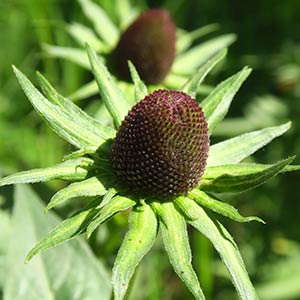Rudbeckia alpicola
Rudbeckia hirta
showy black-eyed susan, showy coneflower, Washington, Washington showy black-eyed susan, Wenatchee coneflower, Wenatchee Mountain, Wenatchee Mountain showy black-eyed susan, Wenatchee Mountains coneflower
black-eyed coneflower, black-eyed susan
hispid to hirsute (hairs spreading, 1+ mm).
green, ovate to elliptic or deltate, pinnate to pinnatifid or lyrate-pinnatifid, herbaceous, faces moderately to densely hairy (hairs 1-seriate);
basal petiolate, 25–70 × 8–45 cm, lobes 3–9, bases rounded to acute, apices acute;
cauline petiolate or sessile, 12–50 × 5–40 cm, bases attenuate to cuneate, ultimate margins dentate to lobed, apices acute.
blades elliptic, lanceolate, or ovate (not lobed), bases attenuate to cuneate, margins entire or serrate, apices acute, faces hispid to hirsute;
basal petiolate, blades 8–30 × 0.5–7 cm;
cauline petiolate or sessile, blades (sometimes pandurate) 3–20 × 0.4–4 cm.
columnar;
paleae 5–7 mm, apices obtuse to acute, often apiculate, abaxial tips hairy.
hemispheric to ovoid;
paleae 4–6 mm, apices acute, often attenuate, abaxial tips hirsute to hispid.
0.
8–16;
laminae (usually uniformly yellow to yellow-orange or with a basal maroon splotch, sometimes mostly maroon) elliptic to oblong or oblanceolate, 15–45 × 5–10 mm, abaxially hispid to hirsute.
300–500;
corollas brown-purple, 4.2–5.8 mm;
style branches ca. 2 mm, apices acute.
250–500+;
corollas proximally yellowish green, distally brown-purple, 3–4.2 mm;
style branches ca. 1.5 mm, apices subulate.
to 6 cm (foliaceous, faces scabrous).
to 3 cm (faces hispid to hirsute).
borne singly or (2–10) in ± corymbiform arrays.
borne singly or (2–5) in loose, corymbiform arrays.
3.5–5 mm;
pappi of 4 scales, to 1 mm.
1.5–2.7 mm;
pappi 0.
30–80 × 18–30 mm.
12–22 × 10–20 mm.
Rudbeckia alpicola
Rudbeckia hirta
Of conservation concern.
Rudbeckia alpicola is known only from Chelan and Kittitas counties.
(Discussion copyrighted by Flora of North America; reprinted with permission.)
Varieties 4 (4 in the flora).
Some strains of Rudbeckia hirta are cultivated and/or used in seed mixes for “re-naturalization” and erosion control.
(Discussion copyrighted by Flora of North America; reprinted with permission.)
1. Annuals, biennials, or perennials; stems branched at bases or proximal to or at or near mid heights, leafy mostly toward bases (leaves smaller distally); peduncles usually at least 1/2 plant heights (Gulf Coastal Plain, Florida to Texas) | → 2 |
1. Biennials or perennials; stems branched mostly beyond mid heights, leafy ± throughout; peduncles to 1/3 plant heights | → 3 |
2. Stems branched mostly at or near mid heights; basal leaves oblanceolate, faces hispid to ± sericeous; Georgia to Texas | var. angustifolia |
2. Stems branched at or near bases (plants often scapiform); basal leaves obovate to nearly orbiculate, faces scabrous to hirsute; c, s Florida | var. floridana |
3. Leaves: basal blades broadly ovate to broadly elliptic, 2.5–7 cm wide (lengths mostly 2 times widths), margins coarsely toothed; cauline (sometimes sessile) lanceolate, ovate, or pandurate (mostly Appalachian Highlands toIllinois) | var. hirta |
3. Leaves: basal blades lanceolate to oblanceolate, 1–2.5(–5) cm wide (lengths 3–5 times widths), margins entire or serrulate; cauline blades spatulate, oblanceolate, or broadly linear | var. pulcherrima |
- Local floras:
BC,
OR,
WA
- Local Web sites:
CalFlora,
CalPhotos,
Flora NW,
Go Botany,
IL Wildflowers,
KS Wildflowers,
LA Plants,
MD Biodiversity,
MI Flora,
MN Wildflowers,
MO Plants,
PNW Herbaria
WildflowerSearch
iNaturalist (observations)
USDA Plants Database
- LBJ Wildflower Center
- SEINet
- Plants of the World Online
- Encyclopedia of Life
- Wikipedia
- Google Image Search


